- Visibility 199 Views
- Downloads 18 Downloads
- DOI 10.18231/j.ijodr.2022.032
-
CrossMark
- Citation
Post orthodontic periodontal evaluation of patients with different removable retainers: Hawleys Vs Essix
Introduction
Prevention of unwanted post-treatment changes remains one of the biggest challenges in orthodontics. There are mainly two types of retainers – removable retainer and permanent retainer and both come with their pros and cons. Removable retainers have become more common for several reasons, including lower costs, better aesthetics, and less time consumed in the laboratory, and they can be removed from the mouth and cleaned by the patient. Some important issues associated with the removable appliance are, they require the patient's cooperation and discipline to follow the instructions, especially during the initial period after the orthodontic treatment. Patients need to be extremely motivated, and their compliance in wearing the retainers is crucial.
Study by Manzon et al[1] suggested that Essix retainers are the most accepted by patients, since they have greater aesthetic and oral comfort characteristics compared with conventional retainers like the Hawleys retainer.[2] However, he has also noted that Essix retainers are more prone to breakage and deterioration, with consequently increased costs, and may cause greater accumulations of plaque on both teeth and retainer, presumably by reducing the cleaning effect of the saliva in the oral regions covered by the thermoplastic resin. Delivering orthodontic treatment outcomes is often compromised by many host variables; the primary amongst them being non-compliance to oral hygiene instructions resulting in a high accumulation of biofilm and plaque. Prolonged contact of the appliance with tooth surfaces, might promote plaque accumulation, enamel demineralization, and caries because of the decreased cleaning effects of saliva and tongue. Among removable retainers, the most used is the Hawley retainer.[2] Another common type is the Essix retainer, manufactured with polypropylene polyvinyl chloride material. It generally fits over the entire arch of teeth, covering their chewing surfaces, and is aesthetic because of its transparency.
Many studies have focused on the efficacy, retention, and cleaning characteristics of these retainers. However, another factor that may influence oral health status and the outcome of the treatment is oral hygiene. During the retention phase, it is an important issue, since the presence of the device in the oral cavity changes the oral environment and alters the microflora. The biofilm formation may affect the patient’s oral and general health. An overall increase in the Streptococcus mutans can lead to caries formation which can lead to a missing tooth that can spoil the overall appearance of the patient. Reidel in his article has given rules and methods to establish successful retention also he successfully noted the challenges faced by orthodontist during the retention phase of the treatment which seems to be noticed by most of the authors during retention phase. [3]
Study by Teurkeoz et al (2012) [4] shows Essix group has a significant increase in the streptococcus mutans count however comparative data was not present in the study. Hibino et al (2009)[5] believed that removable orthodontic appliances could hinder patients from maintaining good oral hygiene and prevent plaque removal either naturally or mechanically. Hence, this study has been carried out to analyse the quantitative changes in the Streptococcus mutans collected from plaque located on the tooth surface of patients who were given removable retainers. In parallel, oral health parameters were monitored by the clinical indices.
Aim
Primary aim was to compare oral bacterial count of patients with Essix retainer and Hawleys retainer this was done using microbial flora examination by quantitatively analyzing Streptococcus mutans as representative of oral flora, Further assessing and comparing periodontal health using Loe plaque index (PI) , Greene and Vermillion calculus index (CI).
Materials and Methods
For this study we have taken 24 subjects who has completed fixed orthodontic treatment out of which 18 are females and 6 males, the study duration was for a period of two months and the study design was prospective in-vivo clinical study.
Inclusion criteria: Patients who have completed active orthodontic treatment using fixed orthodontic appliance MBT technique, patients willing to participate in the study and have given consent, orthodontic patients who are prescribed Hawleys or Essix removable retainers, and Patients in the age group of 18-30 years.
Exclusion criteria: Visually challenged patients, mentally challenged patients, patients with poor history of oral hygiene, patients on medication, syndromic patients, surgically treated cases, cleft lip and palate cases, patients with missing teeth.
For group I subjects, Hawleys retainers were fabricated. Similarly, for group II subjects Essix retainer were delivered Oral Hygiene Index- Simplified (OHI-S), Silness-Loe plaque index (PI) recording at T0, T1, T2 time intervals, by single operator so as to avoid intra operator errors.
|
S.No. |
Details |
Code |
Sample size |
|
Group I |
Hawleys retainer group |
(H) |
12 |
|
Group II |
Essix retainer group |
(E) |
12 |
Supra gingival plaque was collected from premolar and molar region of upper right quadrant by using a cotton swab at 30 days (T1) and 60 days (T2). The collected swab was then placed in a 2 ml sterilized vial with 1 ml phosphate buffered solution. The sample vials were then transported to lab. The collected swab was stored in a -240 ultra-low temperature freezer ([Figure 6]) till it was processed.
The sample in this study was diluted using serial dilution technique ([Figure 2]) and the concentration was set at 10-3. The diluted sample was then inoculated on Mitis Salivarius Agar plates ([Figure 3]) with 0.1% bacitracin which is a selective culture media for S. mutans. ([Figure 4]) The culture plates were inoculated with sample was then stored in an incubator set at 370 for 48 hours ([Figure 5]). When the colony growth was visible culture plates were taken out from the incubator ([Figure 6]), following which the bacterial colony was counted with the help of a Digital colony counter ([Figure 7]) and expressed as Colony forming units per ml (CFU/ml). The indices were recorded and the CFU/ml was then subjected to appropriate statistical tool to meet the objectives of the research.
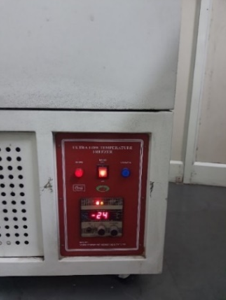
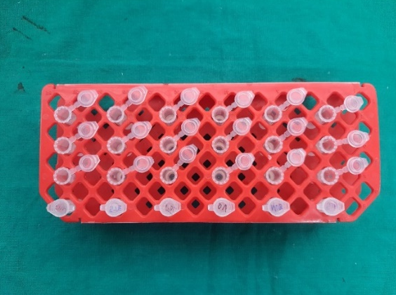
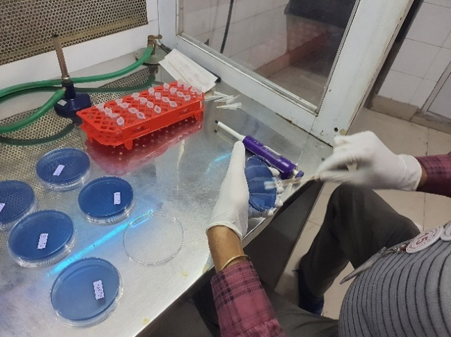
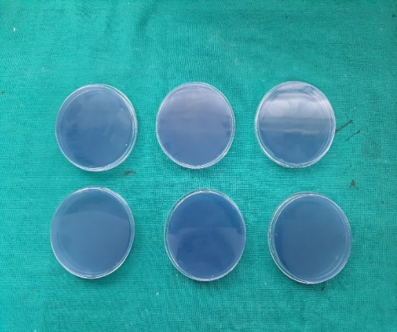
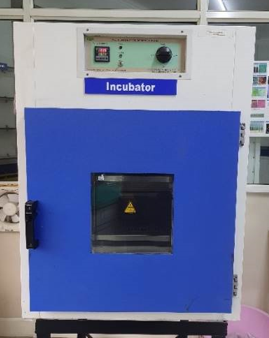
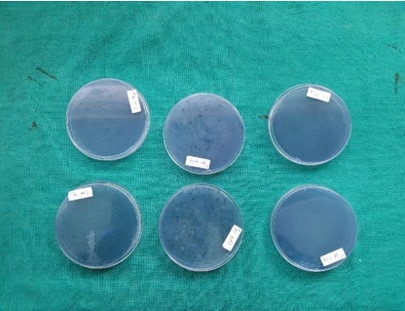
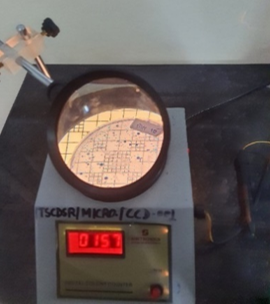
Results
While comparing Intergroup comparison between two groups of CFU/ml at different time intervals shows that at T1(30 days) there was a statistically significant increase (P value 0.001) in the CFU/ml similarly at T2(60 days) there was a statistically significant increase(P value 0.001) in the CFU/ml. These values indicate that for both appliances as the wear time increases the Streptococcus mutans CFU/ml increases. ([Table 2]) But, the level of increase in the Streptococcus mutans CFU/ml was significantly more in group II (Essix retainer) than group I (Hawleys retainer). Further, Intragroup comparison between two groups of CFU/ml at two-time intervals shows that in group I there was statistically non-significant (P value 0.053)increase in the CFU/ml but in group II there was statistically significant (P value 0.001) increase in the CFU/ml. ([Table 3]) These values indicate that for group I as the wear time increases the Streptococcus mutans CFU/ml increases but the colony count increase is statically non-significant however group II as the wear time increases the Streptococcus mutans CFU/ml increases at a statistically significant level.
Further adding to this, Inter group comparison between two groups of OHI-S at different time intervals, ([Table 4]) the OHI-S score shows that group I hawleys group patients was able to maintain the oral hygiene better than group II. The scores in group II was statistically higher, this indicates that in terms of OHI-S score Hawleys is better than Essix (P value 0.001) Intragroup comparison between two groups ([Table 5]) of OHI-S at three-time intervals shows that in group I there was statistically non-significant (P value 0.255)increase in the OHIS-S, similarly in group II there was statistically non-significant(P value 0.744) increase in the OHI-S. These values indicate that for group I hawleys appliance and group II Essix appliance, the OHI-S scores doesn’t change even as the wear time increases.
Similarly, Intergroup comparison between two groups of plaque index (PI) at different time intervals,([Table 6]) PI score shows that group I, patients were able to maintain the oral hygiene better than group II. The scores in group II was statically higher(P value 0.001), this indicates that in terms of PI score Hawleys is better than Essix retainer. Intragroup comparison between two groups of PI index at three-time intervals shows that in group I there was statistically non-significant increase in the PI index.([Table 7]) Similarly, in group II there was statistically non-significant increase in the PI index.(P value 0.053) & P value 0.941) These values indicate that for group I and group II the PI index scores does not change even as the wear time increases.
|
|
GP |
Mean |
Std. Deviation |
Std. Error Mean |
P value |
Significance |
|
T1 |
Group I |
220.17 |
43.628 |
12.594 |
0.001 |
Significant (P<0.05) |
|
Group II |
304.42 |
63.419 |
18.307 |
|||
|
T2 |
Group I |
273.58 |
49.911 |
14.408 |
0.001 |
Significant (P<0.05) |
|
Group II |
378.50 |
59.292 |
17.116 |
|
Groups |
T1 |
T2 |
P value |
Significance |
|
Group I |
220.17±43.628 |
273.58±49.911 |
0.053 |
Non-Significant (P>0.05) |
|
Group II |
304.42±63.419 |
378.50±59.292 |
0.001 |
Significant (P<0.05) |
|
|
GP |
Mean |
Std. Deviation |
Std. Error Mean |
P value |
Significance |
|
T0 |
Group I |
0.850 |
0.193 |
0.055 |
0.001 |
Significant (P>0.05) |
|
Group II |
2.250 |
0.678 |
0.195 |
|||
|
T1 |
Group I |
0.950 |
0.116 |
0.033 |
0.001 |
Significant (P>0.05) |
|
Group II |
2.441 |
0.516 |
0.148 |
|||
|
T2 |
Group I |
1.008 |
0.287 |
0.082 |
0.001 |
Significant (P>0.05) |
|
Group II |
2.383 |
0.487 |
0.140 |
|
Groups |
T0 |
T1 |
T2 |
P value |
Significance |
|
Group I |
0.850±0.193 |
0.950±0.116 |
1.008±0.287 |
0.255 |
Non-Significant (P<0.05) |
|
Group II |
2.250±0.678 |
2.441±0.516 |
2.383±0.487 |
0.744 |
Non-Significant (P<0.05) |
|
GP |
Mean |
Std. Deviation |
Std. Error Mean |
P value |
Significance |
|
|
T0 |
Group I |
0.533 |
0.238 |
0.068 |
0.001 |
Significant (P<0.05) |
|
Group II |
1.466 |
0.238 |
0.068 |
|||
|
T1 |
Group I |
0.666 |
0.226 |
0.065 |
0.001 |
Significant (P<0.05) |
|
Group II |
1.450 |
0.124 |
0.035 |
|||
|
T2 |
Group I |
0.775 |
0.176 |
0.050 |
0.001 |
Significant (P<0.05) |
|
Group II |
1.483 |
0.248 |
0.071 |
|
Groups |
T0 |
T1 |
T2 |
P value |
Significance |
|
Group I |
0.533±0.238 |
0.666±0.226 |
0.775±0.176 |
0.053 |
Non-Significant (P<0.05) |
|
Group II |
1.466±0.238 |
1.450±0.124 |
1.483±0.248 |
0.941 |
Non- Significant (P<0.05) |
Discussion
The Hawley retainer, which was designed in 1919 by Charles Hawley [2] and has been used for nearly a century since is the most popular removable retention appliance. Hawley retainers have a point contact wire on the labial surface and a mass of acrylic approximating the lingual cervix. Maurice J. Meade, Declan T. Millett and Michael Cronin (2014) [6] in their studies showed that overall compliance was greater with Hawley retainers.
Currently, both Essix and Hawley retainers are frequently used in orthodontic practice and there are no clear guidelines about their use. Ezgi Atik, Fatma Esen Aydinli, Mavis Emel Kulak Kayik and Semra Ciger (2016)[7] compared the speech performance of both and concluded that the most apparent changes were found in the [a] vowel in the Hawley group, the [e] vowel in the Essix group, and the [u] vowel in both groups.
Increasing technologies and patients demand to lead to the improvement of the retainer with the concept of best retention. But the use of removable appliances for small movements, retention, and myofunctional therapies results in greater biofilm accumulation on dental surfaces. As time advanced cariogenic properties of retainer came into consideration as there was an adverse effect on oral hygiene of the patients, though the study of authors like Batoni et al (2001)[8] study showed that the presence of any device in the oral cavity changes the oral environment and alters the microbiota and thus the biofilm formation may affect patients oral and general health. Hibino et al (2009)5 believed that removable orthodontic appliances could hinder patients from maintaining good oral hygiene and prevent plaque removal either naturally or mechanically. Al Groosh et al (2015)[9] also investigated the presence of Streptococcus species, Staphylococcus, and Candida in the mouths of Hawley and Essix retainer wearers compared with subjects without retainers and found higher proportions of these pathogens in the retainer groups. Since dental caries, periodontal diseases, and oral infections are related to microbial proliferation, it is important to control biofilm formation on the retainer.
Studies by M. Addy et al (1982), Rourke et al (2016) and S J Littlewood et al (2017)[10], [11], [12] showed that vacuum-formed thermoplastic retainers may have an increased accumulation of material inside their concavities and greater difficulty in cleaning the retainer with the toothbrush. However, any device in the oral cavity can change the oral environment and cause the colonization of pathogens. Another important part of this study is the bacterial count, the biofilm formation may affect the patient’s oral and general health. The overall increase in the Streptococcus mutans can lead to caries formation which can lead to the missing tooth which can spoil the overall appearance of the patient, Streptococcus mutans is considered as a representative of oral bacterial flora, streptococcus mutans is anaerobic bacteria and is an early colonizing species hence the sample is collected only at T1 and T2 not immediately after delivering the appliance which is similar with the studies conducted by Teurkeoz et al (2012).[4]
This study show that Essix retainers cause an increased accumulation of plaque compared with Hawley retainers. Surface characteristics affect the amount of bacterial adhesion to orthodontic materials: surface roughness and surface free energy. A rough surface provides suitable niches for bacterial colonization, and a material with high free surface energy attracts more bacteria. Lessa et al (2007)[13] reported that S mutans colonies were observed on all noninfected acrylic base plates; therefore, the acrylic surface of removable orthodontic appliances acts as a sponge for microbial colonization. Low et al (2011)[14] recently reported that thermoplastic appliances were not completely smooth but had micro-abrasions and irregularities that might contribute to bacterial adhesion.
The results of the present study which shows Essix group has a significant increase in the streptococcus mutans count is in accordance with the study of Teurkeoz et al (2012), [4] however they have compared Essix group with a control group of patients not wearing any appliance. Similarly, our results explain the reason for increased demineralisation in patient wearing Essix.
Intergroup comparison of OHI-S score between two groups at different time intervals was also in favour of Hawleys retainer, suggesting that patients were able to maintain better oral hygiene in Hawleys retainer than in Essix retainer, whereas intragroup comparison of OHI-S score between two groups in 3 different time intervals shows OHI-S scores doesn’t depend on wear time. Intergroup comparison of plaque index (PI) between two groups) at different time intervals shows that Essix retainer has a statistically higher PI score than Hawleys retainer. Similar to OHI-S Score, intragroup comparison of PI score between two groups in 3 different time intervals PI score was not time-dependent. The results of this study were similar with studies by Licia Manzon et al (2018), [1] Low et al (2011)[14] and Cifter et al (2017).[15]
Despite the findings of the plaque indexes, Essix retainers are more comfortable to wear compared with Hawley retainers. These data are in line with those of other studies such as Georgia Vagdouti et al (2019)[16] showing that Essix retainers are more comfortable, aesthetic, and easier to wear than Hawley retainers. In addition, they are less expensive and less visible. Thus, the final choice of the type of retainer should be dictated by many factors, including age, maturity, compliance, type, and outcome of the orthodontic intervention.
Conclusion
It is important that as part of the informed consent process, patients are made aware of the limitations of orthodontic treatment and the need for retention. Permanent retention is the better way to ensure long-term post treatment stability. Orthodontists should take a more proactive approach in dealing with the factors associated with relapse. Relapse is unpredictable but likely, and patients should only undergo orthodontics if they are willing and capable of following the prescribed retention regimen following active treatment. The aim should be to remove the primary burden of preventing relapse from patients, along with this orthodontist should also take care about the gingival and periodontal health during retention phase. Another factor that may influence oral health status and the outcome of the treatment is oral hygiene. During retention phase it is an important issue, since the presence of the device in the oral cavity changes the oral environment and alters the microflora. The biofilm formation may affect patient’s oral and general health. Overall increase in the Streptococcus mutans can lead to caries formation which can lead to missing tooth which can spoil the overall appearance of the patient.
The results of the study revealed the following:
Intergroup comparison between two groups of CFU/ml at different time intervals shows that at T1(30 days) and T2(60 days) there was increase in the CFU/ml.
Intragroup comparison between two groups of CFU/ml at two-time intervals shows that in Hawleys patients there was non-significant increase in the CFU/ml but in Essix patients there was significant increase in the CFU/ml.
Intergroup comparison between two groups of OHI-S at different time intervals, the OHI-S score shows that hawleys group patients was able to maintain the oral hygiene better than Essix group.
Intragroup comparison between two groups of OHI-S at three-time intervals shows that in both groups there was non-significant increase in the OHIS-S.
Intergroup comparison between two groups based on PI score shows Hawleys, patients were able to maintain the oral hygiene better than Essix patients.
Despite the increasing popularity of lingual retainers, the advantages of removable appliances for both the patient and the orthodontist have ensured the continuing relevance of these appliances, and results of this study shows that even though OHI-S and PI scores are not in favour of Essix, it is well accepted by the patients, hence the data from this study advocates the use of a better appliance which along with aesthetics can also ensure better oral hygiene.
Source of Funding
None.
Conflict of Interest
None.
References
- L Manzon, G Fratto, E Rossi, A Buccheri. Periodontal health and compliance: A comparison between Essix and Hawley retainers. Am J Orthod Dentofacial Orthop 2018. [Google Scholar]
- CA Hawley. A removable retainer. Int J Orthod Oral Surg 1919. [Google Scholar]
- RA Riedel. A review of the retention problem. Angle Orthod 1960. [Google Scholar] [Crossref]
- Ç Turkoz, N Canigur Bavbek, S Kale Varlik, G Akça, . Influence of thermoplastic retainers on Streptococcus mutans and Lactobacillus adhesion. Am J Orthod Dentofacial Orthop 2012. [Google Scholar]
- K Hibino, RWK Wong, U Hagg, LP Samaranayake. The effects of orthodontic appliances on Candida in the human mouth. Int J Paediatr Dent 2008. [Google Scholar] [Crossref]
- MJ Meade, DT Millett, M Cronin. Social perceptions of orthodontic retainer wear. Eur J Orthod 2014. [Google Scholar]
- E Atik, F Esen Aydinli, ME Kulak Kayikçi, S Ciger. Comparing the effects of Essix and Hawley retainers on the acoustics of speech. Eur J Orthod 2016. [Google Scholar] [Crossref]
- G Batoni, M Pardini, A Giannotti, F Ota, M Rita Giuca, M Gabriele. Effect of removable orthodontic appliances on oral colonisation by mutans streptococci in children. Eur J Oral Sci 2001. [Google Scholar] [Crossref]
- DH Al Groosh, L Bozec, J Pratten, NP Hunt. The influence of surface roughness and surface dynamics on the attachment of Methicillin-Resistant Staphylococcus aureus onto orthodontic retainer materials. Dent Mater J 2015. [Google Scholar]
- M Addy, W C Shaw, P Hansford, M Hopkins. The effect of orthodontic appliances on the distribution of Candida and plaque in adolescents. Br J Orthod 1982. [Google Scholar]
- N O’rourke, H Albeedh, P Sharma, A Johal. Effectiveness of bonded and vacuum-formed retainers: A prospective randomized controlled clinical trial. Am J Orthod Dentofacial Orthop 2016. [Google Scholar]
- SJ Littlewood, DT Millett, B Doubleday, DR Bearn, H Worthington. Retention procedures for stabilising tooth position after treatment with orthodontic braces. Cochrane Database Syst Rev 2016. [Google Scholar] [Crossref]
- FCR Lessa, C Enoki, IY Ito, G Faria, MAN Matsumoto, P Nelson-Filho. In-vivo evaluation of the bacterial contamination and disinfection of acrylic baseplates of removable orthodontic appliances. Am J Orthod Dentofacial Orthop 2007. [Google Scholar]
- B Low, W Lee, CJ Seneviratne, LP Samaranayake, U Hagg. Ultrastructure and morphology of biofilms on thermoplastic orthodontic appliances in “fast” and “slow” plaque formers. Eur J Orthod 2011. [Google Scholar]
- M Cifter, AD Gumru Celikel, A Cekici, . Effects of vacuum-formed retainers on periodontal status and their retention efficiency. Am J Orthod Dentofacial Orthop 2017. [Google Scholar]
How to Cite This Article
Vancouver
Kumar R, Misra V, Joshi D, Yadav A, Attri S, Johnson S. Post orthodontic periodontal evaluation of patients with different removable retainers: Hawleys Vs Essix [Internet]. IP Indian J Orthod Dentofacial Res. 2022 [cited 2025 Sep 12];8(3):185-191. Available from: https://doi.org/10.18231/j.ijodr.2022.032
APA
Kumar, R., Misra, V., Joshi, D., Yadav, A., Attri, S., Johnson, S. (2022). Post orthodontic periodontal evaluation of patients with different removable retainers: Hawleys Vs Essix. IP Indian J Orthod Dentofacial Res, 8(3), 185-191. https://doi.org/10.18231/j.ijodr.2022.032
MLA
Kumar, Rathin, Misra, Vaibhav, Joshi, Divya, Yadav, Ashish, Attri, Sonal, Johnson, Steffi. "Post orthodontic periodontal evaluation of patients with different removable retainers: Hawleys Vs Essix." IP Indian J Orthod Dentofacial Res, vol. 8, no. 3, 2022, pp. 185-191. https://doi.org/10.18231/j.ijodr.2022.032
Chicago
Kumar, R., Misra, V., Joshi, D., Yadav, A., Attri, S., Johnson, S.. "Post orthodontic periodontal evaluation of patients with different removable retainers: Hawleys Vs Essix." IP Indian J Orthod Dentofacial Res 8, no. 3 (2022): 185-191. https://doi.org/10.18231/j.ijodr.2022.032
